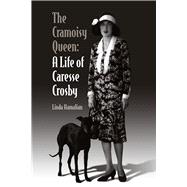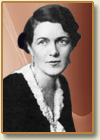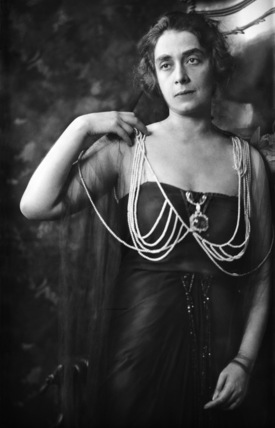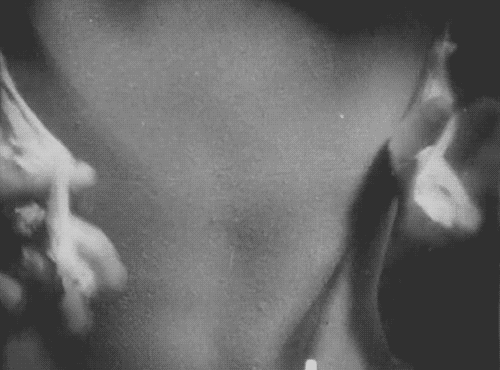
"Quand un salon littéraire devient un boudoir pour dames"
24 Décembre 2012


L'avènement du soutien-gorge C'est une jeune Américaine, Mary Phelps Jacob, dite Caresse Crosby, qui eut l'idée,
en 1913, de fabriquer un soutien-gorge à l'aide de mouchoirs et d'épingles de sûreté. Déposant un brevet l'année suivante, elle tente de le commercialiser. En vain. Elle décide de céder le brevet
à l'entreprise Warner's qui met au point, en 1931, un tissu chaîne et trame, élastique dans les deux sens, qui servira à la confection des premiers modèles. C'est Warner's encore qui crée les
bonnets à profondeur variable, de A à E, les bretelles élastiques et même le bonnet moulé sans couture des années 70. Fruit de recherches qui auront duré près de dix ans, le nylon cher à Du Pont
de Nemours va, lui aussi, bouleverser le monde de la lingerie grâce à des atouts uniques: brillant, solide, séchant vite et ne se repassant pas, il ne sera détrôné par aucun autre textile. Un
coup d'œil sur les étiquettes le confirme: il est plus que jamais présent, jugé indispensable lorsqu'il s'agit de conférer aux fibres naturelles les qualités qu'elles n'ont pas. Mais c'est
incontestablement le lycra qui mérite la qualification de trouvaille du siècle. Appartenant à la famille des fibres synthétiques élasthannes (spandex aux Etats-Unis), ce fil, qui se décline dans
une vaste gamme de titrages, agit comme un véritable ressort, capable de reprendre sa forme initiale, sans déformation, après avoir été étiré jusqu'à sept fois sa longueur. Il a d'autres
avantages dont celui d'améliorer le maintien des tissés, d'augmenter la résistance des mélanges auxquels il participe, de rendre leur entretien très aisé, de jouer les accélérateurs de séchage,
bref, d'apporter à des matières naturelles comme la soie ou la dentelle un maximum de confort et de tonus. Le lycra n'est évidemment jamais utilisé seul. Il serait donc plus juste, précise-t-on
chez Du Pont, de parler d'un vêtement avec lycra, ce qui éviterait la confusion lycra=synthétique.
D'autant plus injustifiée que, combiné au coton ou à la soie, il conserve toujours les qualités de la fibre majoritaire. Autre précision: il peut être transparent, mat ou blanc, et comme il ne
prend pas la couleur, il doit toujours être recouvert d'un fil de nylon qui le protège tout en permettant sa teinture.

Mary Phelps Jacob (20 April 1891 - 24 January 1970) received a patent for a design for first modern brassiere to gain wide acceptance. Along her second husband, Harry Crosby, and after his suicide on her own, she published and promoted many of the early modernist writers. Their Black Sun Press produced works by D.H. Lawrence, Kay Boyle, Ezra Pound, James Joyce, Hart Crane, among others.
Born on 20 April 1891 in New Rochelle, New York, "Polly" (as she nicknamed herself) was the daughter of a prominent New England family. Her ancestry included Governor Bradford, the Plymouth Colony's first governor, and Robert Fulton, developer of the steamboat.
|
|
Polly's family was not fabulously rich, but her father had been raised, as she put it, "to ride to hounds, sail boats, and lead cotillions," and he lived high. She grew up, she later said, "in a world where only good smells existed." "What I wanted," she said of her privileged childhood, "usually came to pass." A childhood of privilege included private school, dancing school, and horse riding school. She was a rather disinterested student. One commentator writes that for the most part Polly "lived her life in dreams." (Wolff).
Her education included private schools and, as was expected for girls of her social class, she debuted at Sherry's and was formally presented at the Court of St. James's.
In 1915, at age 24, Polly Jacob married Richard "Dick" Rogers Peabody, son of one of the three great New England families. By the early 20th century a case could be made that the Peabodies had supplanted the Cabots and the Lodges as the most distinguished name in the area. She had for all intents and purposes arrived socially, having married into American aristocracy. But it was not to last.
Up to this time, an unhealthy and painful device called a corset narrowed an adult women's waist to 13 or fewer inches. The corset is attributed to Catherine de Médicis, wife of King Henri II of France. She enforced a ban on thick waists at court attendance during the 1550s. For nearly 350 years, women's primary means of support was the corset, with laces and stays made of whalebone or metal.
In 1875, designer Susan Taylor Converse created a garment called the “Union Under-Flannel” from woolen fabric. The garment is different to previous items as it has no-bones, eyelets, laces or pulleys. The garment was patented by manufacturers George Frost and George Phelps, but never gained much attention.
In 1889, French-born corset-maker Herminie Cadolle invented a two-part undergarment. The top half of her 1889 invention was "designed to sustain the bosom and supported by the shoulders." (The bottom half was a corset that covered only the waist and rear.) She called it the 'Well-Being' or 'Bien-être'. Introduced in Paris, the Bien-être resembled a Victorian bikini. But Cadolle's far-sighted design seems to have been kept a close secret among her select customers.
Later in 1893, Marie Tucek patented the first brassiere. Her device included separate pockets for the breasts, straps that went over the shoulder which were fastened by hook-and-eye closures. It looked very much like modern bras today, but Marie apparently failed to successfully market the patent.
In 1910, Polly Jacob purchased a sheer evening gown for a social event. At that time, the only acceptable undergarment was a corset stiffened with whalebone. Polly found that the corset's whalebone visibly poked out from her plunging neckline and from under the sheer fabric. Dissatisfied with this arrangement, she worked with her maid to stitch two silk handkerchiefs together with some pink ribbon and cord.
Polly's new undergarment, light and risque for its times, complimented the new fashions introduced at the time. Family and friends almost immediately asked Polly to create brassieres for them, too. One day, she received a request for one of her contraptions from a stranger, who offered a dollar for her efforts. She knew then that this could become a viable business. The corset's reign was beginning to topple.
While similar inventions for supporting the breasts previously existed, Polly was the first to patent an undergarment named 'Brassiere,' derived from the old French word for 'upper arm'.
On November 3, 1914, the U.S. Patent Office issued a patent for the 'Backless Brassiere'. Her patent was for a device that was lightweight, soft and separated the breasts naturally. Polly christened her business with the name Caresse Crosby. While a definite improvement, her brassiere did not offer breasts a lot of support, and were more flattening than flattering. In fact, the breast-flattening style was popularized by the Flapper look during the Roaring Twenties. With the popularity of actresses like Marilyn Monroe and Jane Russell, the present breast-enhancing style gained popularity during the thirties and forties.
Running a business either was not enjoyable to Polly or she failed to properly market the product, for she soon sold the brassiere patent to the Warner Brothers Corset Company in Bridgeport, Connecticut, for $1,500 (or over $25,600 in today's money). Shortly afterwards, in 1917, the U.S. War Industries Board asked women to stop buying corsets to free up metal for war production. This step liberated some 28,000 tons of metal, enough to build two battleships.
It has been said that the bra took off the way it did in large part because of World War I. The Great War shook up gender roles, putting many women to work in factories and uniforms for the first time. Women needed practical, comfortable undergarments. Warner went on to earn more than fifteen million dollars from the bra patent over the next thirty years.
During the flat-chested Flapper era in the 1920’s, a Russian immigrant named Ida Rosenthal noticed that a bra that fit one woman did not fit another woman of the same bra size. With the help of her husband William, they founded Maidenform. Ida was responsible for grouping women into bust size categories (cup sizes) and developed bras for every stage of life (puberty to maturity).
In the 1930s, Warner produces the first popular all-elastic bra, which shows off a woman's curves.
In 1916 and 1917, Polly and Dick Peabody had two children: a son, William Jacob, and a daughter, Polly ("Poleen"). Dick was a well-educated but undirected man and a reluctant father. She found he had only three real interests, all acquired at Harvard: to play, to drink, and to turn out, at any hour, to chase fire engines. His World War I experiences were traumatic and became an alcoholic. Polly's life was difficult during the war years and when her husband returned home, significantly changed, her life soon changed abruptly too.
The catalyst for Polly Peabody's transformation was her introduction and eventual marriage to Harry Grew Crosby, a wealthy scion of a socially prominent Boston family and another veteran and victim of the recent war. Harry attended private schools and until age 19 and he appeared to be well on the path to a comfortable life as a member of the upper middle class. His experiences in World War I changed everything.
In the pattern of other sons of the elite from New England, he volunteered for the American Field Service Ambulance Corps. He served in the Second Battle of Verdun. After the Battle of Orme, his section (the 29th, attached to the 120th French Division) was cited for bravery, and in 1919 Crosby was awarded the Croix de Guerre.
While completing school after WWI, Harry met Polly. She was 28, six years older than Harry, with two small children. By some accounts, Harry fell in love with Mrs. Peabody in about two hours. He confessed his love for her in the Tunnel of Love at the amusement park. Two weeks later they made love. Their scandalous courtship was the gossip of blue-blood Boston. Polly finally divorced Richard Peabody who was in and out of sanitariums fighting his alcohol abuse, and on September 9, 1922 Harry and Polly were married. Two days later they moved to France to join other American expatriates, probably much to the relief of their respective families.
At first they lived in Paris, then they bought a restored mill in the suburb of Ermenonville, which they called Le Moulin du Soleil ("The Mill of the Sun"). They partied with artists and socialites, met with writers, studied literature, and began to both write and publish their own work.
Harry at first worked for his famous uncle, American capitalist J.P. Morgan, who was also Harry's godfather, in a job arranged for him in a Paris bank. But he soon tired of the working life and by the end of 1923 Harry quit the banking job. Harry At the end of 1924, Harry persuaded Polly to formally change her first name to Caresse.
Polly and Harry purchased a race horse and then two more. They traveled to North Africa where it is reported they first smoked opium, a habit to which they would return again and again. From 1922 to 1925, the Crosbys led the life of the rich expatriates. They lived a glamorous and luxurious lifestyle that included an "open marriage," a mutual suicide pact, and cremation instructions they carried with them. Their lifestyle was financed by selling the bonds and stocks whose dividends were previously the basis of Harry's income. Harry at one point sent a telegram to Boston: "PLEASE SELL 10,000 WORTH OF STOCK. WE HAVE DECIDED TO LEAD A MAD AND EXTRAVAGANT LIFE."



After publishing two volumes that they were unhappy with, the Crosbys found a master printer named Roger Lescaret whose previous work had been largely funeral notices. He printed Harry’s poems in a fine edition. Harry and Caresse were very happy with the book, Red Skeletons. It contained illustrations by their friend Alastair (Hans Henning von Voight). The decided to found a press, first called Éditions Narcisse— after their black whippet, Narcisse Noir. It was created to publish its founders’ attempts at verse in beautifully bound, hand-set books.
By the time the name of the press was changed in mid-1928 to the Black Sun Press, the careers of both the Caresse and Harry Crosby were in high gear. The Black Sun Press is famous for having published lavishly bound, typographically impeccable versions of unusual books, including The Fall of the House of Usher, their Hindu Love Book, and letters by Henry James to Walter Berry, Harry’s cousin. As their literary tastes matured, they began to publish the works of their Parisian literary friends. This included D. H. Lawrence’s The Sun and Escaped Cock (sometimes reprinted under the title The Man Who Died); James Joyce’s Tales Told of Shem and Shaun (work — later incorporated into Finnegans Wake; and short stories by Kay Boyle. In 1929, their best year, they published fourteen works by James Joyce, Ernest Hemingway and Ezra Pound, among others. Caresse published her own book of poetry, Crosses of Gold.
The Crosbys had what people later in the twenty-first century would call an "open marriage" and both had numerous extramarital affairs. Harry's was a womanizer, gambler, alcoholic, and opium smoker. They apparently remained devoted to each other nonetheless. While Caresse maintained the joie de vivre of a moneyed and carefree 1920s heroine, Harry grew darker in his moods and became increasingly obsessed with death.
In 1928, Harry Crosby met Josephine Noyes Rotch, whom he would call the "Youngest Princess of the Sun" and the "Fire Princess." She was descended from a family that first settled in Provincetown on Cape Cod in 1690. Josephine would inspire Crosby's next collection of poems called Transit of Venus. Miss Rotch was twenty, ten years younger than Harry. The two fell in love. In a letter to his mother, dated July 24, 1928, Crosby wrote:
I am having an affair with a girl I met (not introduced) at the Lido. She is twenty and has charm and is called Josephine. I like girls when they are very young before they have any minds.
Josephine and Harry had an ongoing affair until she married, when it ceased. Then Josephine Bigelow's new husband got busy with school, and Josephine contacted Harry again. Their affair rekindled, they traveled to Detroit and checked into an expensive, $12 a day hotel as husband and wife. For four days they took meals in their room, smoked opium, battled, and made love.
On December 7, 1929, the lovers returned to New York where they agreed that Josephine should return to Boston to her husband. But on December 9 she had delivered a 36-line poem to Crosby who was staying with Caresse at the Savoy-Plaza Hotel. The last line of the poem is:
Death is our marriage.
On December 9, Harry Crosby made the following entry into his notebook:
One is not in love unless one desires to die with one's beloved. There is only one happiness it is to love and to be loved.
These are Crosby's very last entries into his journal. On December 10, 1929, in an apparent suicide pact, Harry was found in bed with a .25 caliber bullet hole in his right temple next to Josephine, who had a matching hole in her left temple. Harry was still clutching the pistol in one hand, Josephine in the other. Harry apparently shot Josephine and then, according to the coroner, several hours later, he shot himself.
After Harry Crosby's suicide, Caresse continued her writing and publishing work at Black Sun. She also established Crosby Continental Editions, a book company that published paperback books by Ernest Hemingway, William Faulkner, Dorothy Parker, among others.
In 1937, at age 47, she married Selbert Young, a football player nearly twenty years her junior. She bought and renovated Hampton Manor, a ruined but splendid home in Bowling Green, Virginia. She opened an art gallery in Washington D.C. and started Portfolio, a magazine about art and literature. She also was politically active and founded the organization Women Against War. She later bought a castle north of Rome that gave her the title of Principessa, and later mountain-top retreats in Cyprus and Delphi. Thus she had homes in Bowling Green, Virginia, in Washington, D.C., a sprawling apartment at 137 East Fifty-Fourth Street in New York City, as well as her residences in Europe.

|
|
Henry Miller and Opus Pistorum
In Paris during 1933, Caresse had met Henry Miller. When he returned to the U.S. in 1940, he confessed to Caresse his lack of success in getting his work published. Miller's autobiographical book Tropic of Cancer was banned in the U.S. as pornographic, and he could get no other work published. She invited him to take a room in her New York apartment where she infrequently lived, which he accepted, though she did not provide him with money.
Desperate for cash, Miller fell to churning out pornography on commission for an Oklahoma oil baron, but after two 100-page stories that brought him $200, he could do no more. Now he wanted to tour the United States by car and write about it. He got a $750 advance, and persuaded the oil man's agent to advance him another $200. He was preparing to leave on the trip but still have not provided the work promised. He thought then of Caresse Crosby. She was already pitching in ideas and pieces of writing to Anaïs Nin's New York City smut club for fun, not money. Caresse was facile and clever, wrote easily and quickly, with little effort.
Caresse accepted Henry's proposal. She wrote the title given her by Henry Miller "Opus Pistorum" at the top, and started right in. Henry left for his car tour of America. Caresse churned out 200 pages and the collector's agent asked for more.
Caresse's smut was just what the oil man wanted-no literary aspirations-just plain sex. In Caresse the agent had found the basic pornographic Henry Miller. Caresse churned out another 200 pages, spending her time writing while her husband, Bert Young, fell into a drunken stupor every night.
In her diary, Anaïs Nin observed that everyone who wrote pornography with her wrote out of a self that was opposite to her or his identity, but identical with his desire. Polly or Caresse experienced years of social constraints imposed by her upper-class association in New York. She had a doomed and troublesome romanticism with Harry Crosby. She participated in a decade or more of intellectual lovers in Paris during the 1920s. Perhaps it was a release for Caresse just to take love as casual lust and let it go at that.
In 1950 Caresse divorced Bert Young and moved to Rocca Sinibalda, Italy where she planned to create an artists colony. She published an autobiography in 1953 called The Passionate Years. In the last years of her life, Crosby tried to build a world citizen center that would bring together political leaders and the artistic community in Greece and then in Cyprus. She was frustrated by political obstacles. She hired her friend Buckminster Fuller to design the structure, but she died in Rome of heart failure in 1970 at age 79, before its completion.
Like Harry, Caresse Crosby is remembered primarily for her activities as a publisher, but she is also remembered as the inventor of the first modern bra. Caresse died in relative obscurity, but she lived long enough to see the bra go through a number of transformations and become immensely popular all over the world.
All kinds of bras have been created for every conceivable purpose, to do all the things that corsets have done in previous generations: minimize, uplift, show cleavage, maximize, or plain show off. Training bras for newly developing young girls seem like an oxymoron, and in reality aren't really meant for support as much as for camouflage. Jogging or sports bras are a more recent innovation for the woman who wants to work out, and some are meant to be worn as outerwear. Statistics show the average American woman today owns six bras. Out of those six, one of is a strapless bra and one is a color other than white.
Despite all of the many advances and improvements in brassieres, perhaps a Surgeon General's warning is still required. In 1994, Berbel Zumner, age 23, was walking through a park in Vienna. Berbel had large breasts and wore a brassiere with underwire support to support her ample frame. She was killed when lightening struck her brassiere.
[in 2004, it was reported that a movie about Harry and Caresse was in development by Fine Line Features. Only a
director has been attached to the project, and no completion date has been set.]

Harry Crosby par Caresse Crosby

A cette époque-là, Paris valait toujours la peine. La ville pendant les Années folles est une fête pour les jeunes gens qui avaient fait la guerre et qui ne savaient pas encore qu'ils seraient tous une génération perdue, comme Gertrude Stein en fera la remarque à Ernest Hemingway. Après la guerre, les rescapés des tranchées cherchent l'oubli dans les nuits blanches et les plaisirs du sexe, sous le fouet de la drogue et de l'alcool.
La ville devient le royaume et l'exil de noctambules soucieux de mettre de la poésie dans leur pain quotidien. Ces assoiffés de vie intense et de libertés en tout genre comptent dans leurs rangs de nombreux Anglo-Saxons, bien servis par un change qui favorise les porteurs de dollars. Parmi eux, Harry et Caresse Crosby, un couple plein de charme, de désirs et d'inquiétudes, sans soucis d'argent: les Amants du Soleil noir de Dominique de Saint Pern.
Harry a connu le drill des écoles bostoniennes et lu les Rubaiyat d'Omar Khayyam avant de s'engager dans les Ambulance Corps (comme Dos Passos, Hemingway, Julien Green et quelques autres) et de se retrouver pour quelques mois somewhere in France, entre Verdun et le Chemin des Dames, au centre de l'enfer. Caresse, mariée, deux enfants, a pour elle d'avoir inventé le soutien-gorge. Leur rencontre décide de leur vie. Ils fuient les promesses d'un avenir aussi confortable que conventionnel et s'installent à Paris, où ils prennent aussitôt une place sans pareille dans une constellation d'extravagants où brillent à feux égaux les grands noms de l'aristocratie - Noailles, Beaumont, La Rochefoucauld - de la bohème et de la littérature.
Harry et Caresse sont deux âmes sensibles, exaltées et exigeantes. Le couple, lié par un amour presque mystique, s'autorise toutes les libertés. La jouissance de l'instant ne leur suffit pas: ils veulent chacun à leur manière laisser leur signature sur l'écorce du monde. Ils écrivent des poèmes, fondent une maison d'édition, Black Sun Press, et participent à l'aventure de Transition, la revue des Jolas, qui publie Paul Bowles et James Joyce, et dont le quartier général se tient alors à la Boisserie de Colombey-les-Deux-Eglises, que n'a pas encore rachetée le général de Gaulle.
L'incandescence appelle souvent la brièveté. Pour Harry, il y a tant de choses à vivre que la mort devient une solution. Paul Morand rappelait dans Venises que les Années folles avaient été une bousculade de rêves inaccomplis, souvent terminés en suicides. La peinture par Saint Pern de cette époque est précise et évocatrice, éclairée par l'embrasement de ces deux comètes, Harry et Caresse, mais la mort n'en est jamais absente.
